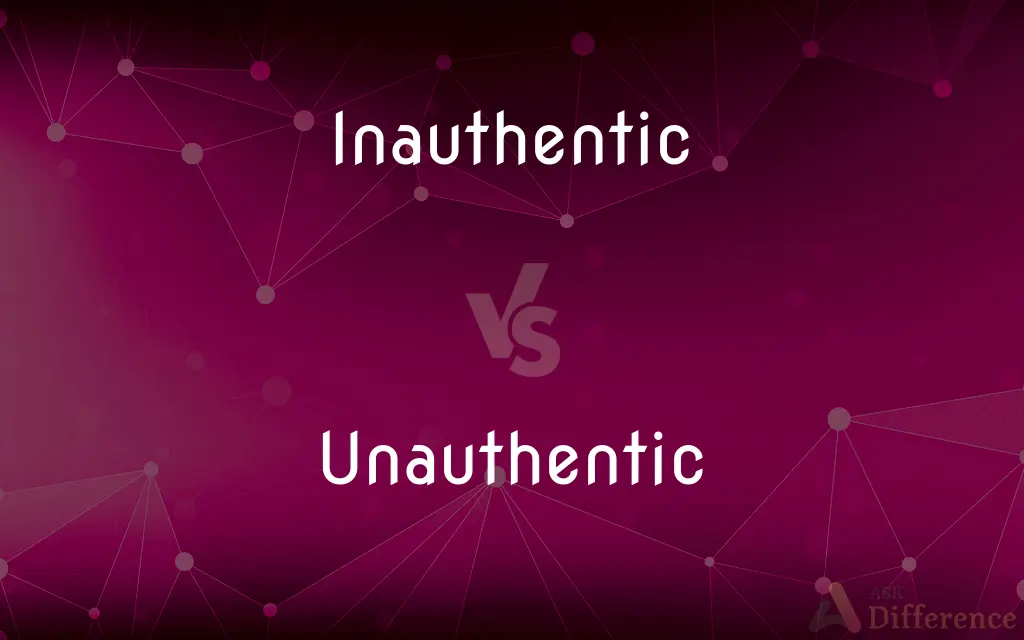Inauthentic vs. Unauthentic — What's the Difference?
By Tayyaba Rehman & Maham Liaqat — Updated on April 3, 2024
Inauthentic refers to something not genuine or lacking authenticity, while unauthentic is less commonly used but conveys a similar meaning of not being authentic or original.

Difference Between Inauthentic and Unauthentic
Table of Contents
ADVERTISEMENT
Key Differences
Inauthentic is widely used to describe actions, materials, or statements that are not genuine or do not reflect one's true self or intentions. It implies a degree of fabrication or artificiality, suggesting that something is made to appear real or valuable when it is not. For instance, inauthentic art pieces are those created to mimic the style of genuine works but lack the originality and value of an authentic piece. On the other hand, unauthentic, though less common in usage, also describes something that lacks authenticity or originality. It's often used interchangeably with inauthentic in everyday language, but its less frequent use might not carry the same immediate recognition or impact.
When discussing personal behavior or social interactions, describing someone as inauthentic suggests that their actions or expressions do not align with their true feelings or beliefs. This term is often used in psychology and sociology to discuss the authenticity of an individual's identity or actions. Meanwhile, unauthentic, although it can be used in similar contexts, is less likely to be found in academic or professional discussions on authenticity. Its usage might be more prevalent in casual or less formal settings.
In the context of products or artifacts, inauthentic items are those that have been produced to imitate or replicate the original items without authorization or adherence to the original quality and essence. This term is frequently used in the art, fashion, and consumer goods industries to highlight the lack of originality and the potential deception involved in the creation and selling of such items. Conversely, unauthentic products might also refer to replicas or imitations, but the term's rarity makes it less common in discussions about counterfeit goods or intellectual property infringement.
Culturally, inauthentic experiences or expressions are those that are engineered to simulate a certain cultural significance or appeal without embodying the true essence or meaning of the culture they aim to represent. This term is significant in discussions about cultural appropriation and the commercialization of cultural practices. Unauthentic, in similar cultural discussions, might be used to express a lack of genuineness or original cultural value, although inauthentic is the preferred term for its precision and commonality in such debates.
Comparison Chart
Common Usage
Widely used to denote lack of genuineness
Less commonly used, similar meaning
ADVERTISEMENT
Contexts
Personal behavior, art, cultural expressions
Interchangeable with inauthentic in casual speech
Implication
Fabrication, artificiality
Similar implications, but less frequently used
Industry Usage
Common in discussions about art, fashion, consumer goods
Less common in professional discussions
Cultural Significance
Used in debates on cultural appropriation
Less prevalent in cultural discussions
Compare with Definitions
Inauthentic
Failing to represent true beliefs or emotions.
Her inauthentic smile hid her real feelings.
Unauthentic
Lacking authenticity or genuineness.
Critics dismissed the artifact as unauthentic, doubting its historical accuracy.
Inauthentic
Not genuine in expression or action.
He gave an inauthentic apology, clearly not regretting his actions.
Unauthentic
Pertaining to an imitation.
The unauthentic handbag, though cheaper, couldn't match the quality of the real thing.
Inauthentic
Reflecting a departure from one’s true self.
Under pressure, his inauthentic side emerged, prioritizing others' expectations over his beliefs.
Unauthentic
Signifying something not certified as genuine.
The document was considered unauthentic due to missing verification.
Inauthentic
Designed to deceive or conform.
The inauthentic narrative was crafted to gain sympathy.
Unauthentic
Not original or made as a copy.
The unauthentic painting was a skillful reproduction, not an original.
Inauthentic
Lacking in sincerity or integrity.
Inauthentic comments on social media often seek approval rather than express true opinions.
Unauthentic
Reflecting a lack of originality.
The unauthentic design failed to impress those familiar with the original.
Inauthentic
Not genuine or authentic.
Unauthentic
Not authentic
Inauthentic
Not authentic or genuine; spurious.
Unauthentic
Intended to deceive;
A spurious work of art
Inauthentic
Intended to deceive;
A spurious work of art
Common Curiosities
Are inauthentic items always counterfeit?
Inauthentic items include counterfeits but also encompass any products designed to imitate without maintaining original quality or value.
Why is authenticity important in cultural expressions?
Authenticity maintains the integrity, significance, and respect of cultural practices, ensuring they're represented and engaged with genuinely.
How is unauthentic different from inauthentic?
Unauthentic conveys a similar meaning to inauthentic but is less commonly used. Both indicate a lack of authenticity.
Can unauthentic be used in formal writing?
While understandable, inauthentic is preferred in formal writing due to its clearer implications and more widespread recognition.
How does the concept of inauthenticity apply to personal behavior?
In personal behavior, inauthenticity refers to actions or expressions that do not reflect one's true feelings, beliefs, or intentions.
Can a business be inauthentic?
Yes, a business can be inauthentic if it promotes values, messages, or products that do not align with its actual practices or origins.
What role does authenticity play in art?
In art, authenticity is crucial for valuing the originality, creativity, and intended expression of the artist, distinguishing genuine works from imitations.
What does inauthentic mean?
Inauthentic describes something not genuine, lacking true authenticity or originality.
How do consumers perceive inauthentic products?
Consumers might view inauthentic products as less valuable, potentially deceptive, and lacking the quality or essence of genuine items.
How do inauthentic cultural experiences affect communities?
Inauthentic cultural experiences can dilute, misrepresent, or commercialize cultural practices, impacting the community's identity and heritage.
Can someone be unintentionally inauthentic?
Yes, individuals can be unintentionally inauthentic if they are unaware of the disparity between their actions and their true selves or intentions.
Is there a difference in the severity of being called inauthentic vs. unauthentic?
The impact is similar, though inauthentic might carry more weight due to its common usage and clear association with lack of genuineness.
What is the significance of authenticity in social media?
In social media, authenticity is valued for fostering genuine connections, trust, and credibility among users and audiences.
Is inauthenticity always negative?
While generally viewed negatively, inauthenticity can also prompt discussions on values, self-awareness, and cultural understanding.
How can individuals and businesses cultivate authenticity?
By aligning actions with core values, being transparent, and engaging genuinely with their audiences, communities, or cultural practices.
Share Your Discovery

Previous Comparison
Rouzed vs. Touzed
Next Comparison
Integration vs. IntegrityAuthor Spotlight
Written by
Tayyaba RehmanTayyaba Rehman is a distinguished writer, currently serving as a primary contributor to askdifference.com. As a researcher in semantics and etymology, Tayyaba's passion for the complexity of languages and their distinctions has found a perfect home on the platform. Tayyaba delves into the intricacies of language, distinguishing between commonly confused words and phrases, thereby providing clarity for readers worldwide.
Co-written by
Maham Liaqat














































